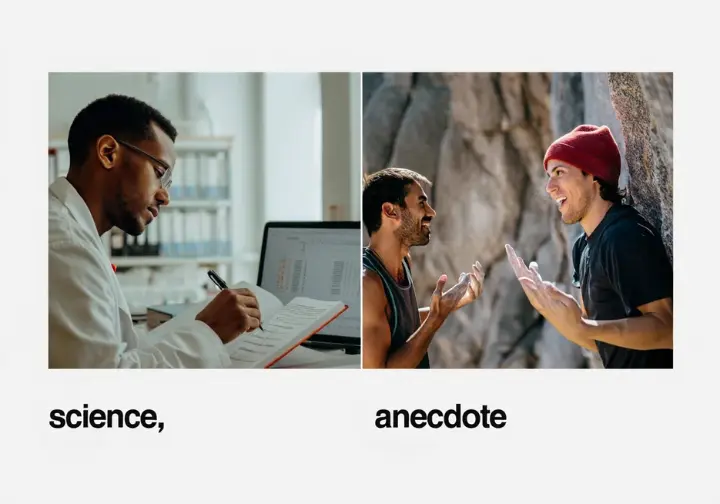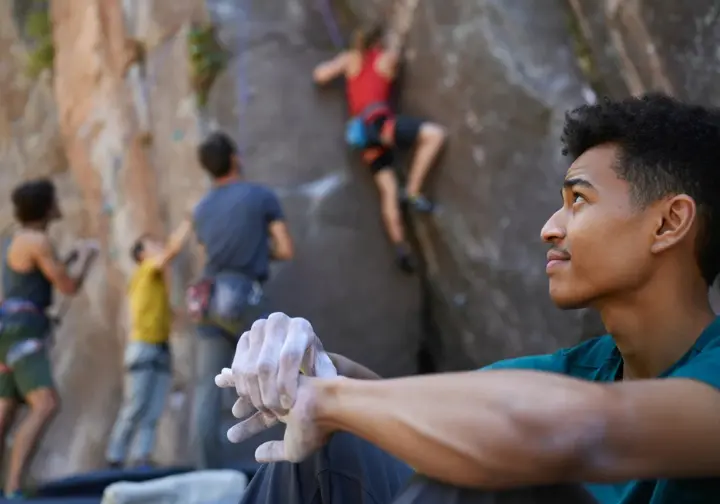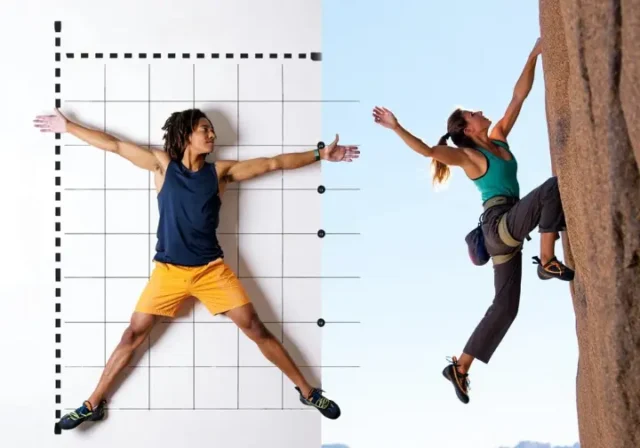In this article
The ape index often surfaces in climber conversations, sometimes sparking debate. Climbers are curious about its true importance for any climb. We will look into what the ape index means, how to measure it, and its real effect on climbing. This piece aims to separate widely held beliefs from what studies show, offering a full view of the ape index rock climbing phenomenon. Let’s explore this topic to better understand your own reach and how it affects your scaling ability on the wall.
What Exactly Is the Ape Index in the Context of Climbing?

To understand the ape index’s role in climbing, we first need a solid grasp of what it is. This involves its definition, how it originated, the methods for its calculation, and distinguishing it from things with similar names. We’ll cover the “ape index definition” and how to “calculate ape index for climbing” to build this foundation, looking at various ape indexes.
Defining the “Ape Index”: Arm Span vs. Height
The ape index, sometimes called “ape factor” or “gorilla index,” is an anthropometric measurement comparing an individual’s arm span (wingspan) to their overall height. It’s a ratio or difference that fuels discussion on its athletic role, particularly in climbing where reach seems vital. This measurement quantifies an individual’s arm span relative to their stature, offering a specific descriptor of physique for any climber.
In climbing circles, a “positive ape index“—arm span exceeding height—is often linked to an advantage. This suggests an ability to grasp holds that might challenge those with neutral or negative ape indexes. A “negative ape index,” where arm span is shorter than height, is sometimes viewed as a drawback. We will touch upon what these terms mean at a basic level for those new to bouldering or rope climbs.
It’s good to remember the ape index is one of many physical characteristics a climber possesses. While it indicates reach potential, it doesn’t cover finger strength, technique, flexibility, or mental fortitude, all of which play significant roles in overall climbing ability, whether on a boulder or a towering cliff. An excellent climber develops all these facets.
Historical Roots: From Vitruvian Man to Modern Climbing
The idea of ideal human proportions, where wingspan equals height, has historical roots in human proportion, famously shown in Leonardo da Vinci’s “Vitruvian Man” around 1492. This drawing, based on Vitruvius’s writings, depicted the human form of the ape (referring to humans as primates) fitting into a circle and square, symbolizing harmony with an ape index ratio of 1.0.
This classical ideal of symmetry, a neutral ape index, contrasts with the common climbing view that a positive ape index is more desirable. This difference shows how sports can value physical traits differently from historical or aesthetic ideals. Knowing this history helps frame the discussion about the ape index’s role in climbing today, including understanding various height indexes.
It reveals that while a 1:1 ratio was once considered “perfect,” climbing’s demands led to new views on what might be “advantageous.” This shift is part of understanding the ongoing “myth vs. reality” debate surrounding the ape index in rock climbing.
How to Accurately Calculate Your Ape Index: Ratio vs. Subtraction
Two main methods exist to calculate and express the ape index; knowing both helps in accurately interpreting information. The first is the Ratio Method: Ape Index = Arm Span / Height. This provides a dimensionless number, like 1.0 or 1.05, useful for scientific comparisons as it’s unit-independent. An ape index calculator can simplify this.
The second is the Subtraction Method: Ape Index = Arm Span – Height. This gives a value in the measurement units used, such as +2 inches or -3 cm. Climbers often prefer this for its direct understanding of how their span compares to their height. There are several methods to calculate ape index available for reference. Understanding these ape index differences is key.
To measure your arm span, stand with your back against a wall, arms extended sideways in a ‘T’, parallel to the floor. Measure from one middle fingertip to the other. For height, measure from the floor (bare feet) to the top of your head, shoeless.
Important Distinction: The Concept vs. “Ape Index Climbing Gym”
When researching the ape index, it’s important to make a key distinction to avoid confusion. The “ape index” as an anthropometric measurement relates to human physiology and its potential implications for climbing performance, which is our focus. This concept is widely discussed in climbing communities and sports science, especially regarding ape index rock climbing.
Separately, a business named “Ape Index Climbing Gym” exists in Peoria, Arizona. This is a physical climbing gym where people can go to climb and train, perhaps even tackle some gym rock routes or boulder problems. Searches for “ape index climbing” might lead to this climbing gym. You can find details about the climbing facility if you are looking for that specific venue.
While the gym’s name is a clever play on words, it serves a navigational intent for those seeking that facility. This article focuses on the broader physiological concept and its relevance to climbers everywhere, not this specific climbing gym.
The Great Debate: Ape Index in Rock Climbing – Science, Anecdote, and Your Reach

We now explore the core of the ape index discussion, comparing scientific research with common beliefs in the climbing community. This will help clarify its actual impact on “ape index rock climbing performance” and examine the “scientific validity of ape index.” Understanding the average ape index is also part of this.
Scientific Studies: What Research Reveals (and Doesn’t)
Scientific inquiry into the ape index’s link to climbing performance shows mixed, often inconclusive, results. Some studies indicate a slight positive correlation, suggesting a higher ape index might offer some benefit for a climber. It’s rarely a strong predictor of ability when viewed alone.
A Systematic review on climbing performance determinants by D’Silva et al. (2024) noted that while some body measurements correlate, training and strength metrics are often more telling for those who climb. Other research on young competitive sport climbers by Watts et al. (2003) found no significant ape index correlation with ability within their group of climbers.
Inconsistencies arise from varied methods, small samples, diverse climbing types (bouldering vs. sport vs. trad), and the challenge of isolating one trait. The complex mix of physical, technical, and mental factors in climbing success means science lacks a simple “yes” or “no” on its definitive importance for a climber. An Ozimek et al. (2023) review also found no ape index differences between sport climber groups.
Anecdotal Evidence & Prevailing Community Beliefs
Despite mixed scientific views, the belief that a positive ape index provides a significant advantage is common among climbers. Stories circulate about how reach affected specific moves or the ability to free climb certain routes, reinforcing the idea that longer arms are inherently better. Online forums host many climber discussions on ape index and its impact.
This anecdotal evidence, though not scientifically strict, reflects genuine climber experiences and shapes the ape index “mythos.” These community perceptions of reach advantage are widespread. This strong community belief can be a powerful psychological factor for any climber. Some even jokingly refer to other metrics like a “sloth index” for particularly slow movers or a “hobbit index” for those with large feet, though these lack any scientific basis unlike the debated ape index.
Climbers with a high positive index might feel more confident. Those with a negative ape index might feel disadvantaged, sometimes using it as a reason for not completing a climb. Acknowledging these beliefs while encouraging a critical view of all success factors is important, especially after a tough session, during the apres-climb chat.
The “Average” Ape Index: Climbers vs. General Population
The general population usually has an ape index ratio near 1.0, meaning arm span (wingspan) roughly equals height. This aligns with the Vitruvian ideal. While variations are normal, a 1:1 ratio is often cited for the average ape index.
Some studies, like Watts et al. (2003), suggest climber groups, especially young competitive ones, might average a slightly higher ape index compared to non-climbing athletes. This could imply self-selection or a minor inherent advantage drawing individuals with slightly longer reach to climbing. The Somatic Profile of Competitive Sport Climbers by Tomaszewski et al. (2011) also found climbers had greater arm spans.
Lattice Training data indicates a typical subtraction method range of -3 to +3 inches for the general population. While some elite climbers show a massive ape index, the average ape index among dedicated climbers isn’t always drastically different. A Body Composition and Anthropometric Parameters Review by Ozimek et al. (2023) provides further context. Treat “average” figures carefully due to variability in different ape indexes.
Biomechanical Implications: How Ape Index Influences Movement

This part looks at the practical ways different ape indexes can affect a climber’s movement, reach, leverage, and potential for strain. We’ll consider the “biomechanical advantage of ape index” and its relation to “climbing movement efficiency” for any climber, including boulderers.
Positive Ape Index: The Reach Advantage & Leverage Trade-offs
A positive ape index (wingspan > height) intuitively gives a reach advantage. Longer-armed climbers can often access further holds, possibly simplifying sequences or using beta unavailable to short climbers. This is noticeable on routes with long, static moves, impacting how one might free climb a route.
However, longer limbs can have biomechanical trade-offs of longer arms. Experts suggest that while reach is better, longer arms mean the shoulder may need to produce more force to maintain stability, potentially increasing strain or the need for greater shoulder strength. This is detailed in studies on the Biomechanics of Rock Climbing Technique. The important index here is not just reach but functional strength.
Longer arms might also alter leverage in certain positions. In compressed moves, very long arms could feel awkward, requiring complex body positioning. So, while a positive ape index is often desired for its reach benefits, it has its own biomechanical aspects to manage for any climber, especially a heavy climber who might feel more strain.
Negative Ape Index: Challenges and Potential Compensations
Climbers with a negative ape index (wingspan < height) might find long reaches challenging. They may need to employ more dynamic movements, use higher foot placements with their feet, or find intermediate holds. This can make some routes or boulder problems feel harder or demand creative problem-solving.
Shorter arms, however, can offer leverage advantages. Some experts suggest those with negative ape indexes might find their shoulders have more leverage, potentially making dynamic moves or lock-offs feel comparatively easier. The Biomechanics of The Drop Knee can be relevant here, affecting balance.
Climbers with a negative ape index often develop excellent technique, body positioning awareness, and dynamic skills. They become skilled at generating momentum and using their entire body efficiently. A negative ape index doesn’t prevent high-level climbing; many succeed by compensating with other attributes, becoming strong climbers.
Ape Index and Specific Climbing Moves or Styles
Ape index relevance can change with the climbing move or style. On routes with long, static reaches between good holds (“ladders”), a positive ape index might offer a clearer advantage, helping climbers maintain stability and save energy. This can influence on various types of climbing moves on the wall.
In “scrunchy” or compressed climbing, like on overhangs with close holds or in tight corners and a gorge, very long arms might feel awkward. Short climbers might find these situations more natural. Understanding anthropometric characteristics in different climber groups can offer insights for various indexes.
For dynamic moves (dynos), while reach is a factor, power generation and limb leverage also play complex roles. Some argue shorter limbs accelerate faster. In slab climbing, where balance and delicate footwork are key, ape index is generally less critical than technique. Similarly, in crack climbing, technique often matters more than reach, though reach can help with mastering advanced techniques like tackling overhangs and challenging free climbs.
Beyond the Tape Measure: Ape Index in the Broader Climbing Context

This section situates the ape index within the wider scope of climbing performance. We’ll discuss if “ape index training” is possible, its psychological effects, and how it stacks up against other vital success factors for a climber, including its “psychological impact on climbers.”
Is the Ape Index Trainable or a Fixed Trait?
The ape index is mainly set by bone structure—arm bone length (wingspan) and shoulder width relative to height. Bone growth largely finishes after puberty. For this reason, the ape index is generally seen as an untrainable characteristic for any climber.
You cannot meaningfully lengthen bones through exercise after growth. While flexibility and mobility work can help climbers maximize their functional reach—using existing limb length effectively—this doesn’t alter skeletal measurements or the ape index. This is a fixed physiological trait determined by genetics.
Climbers should see their ape index as a fixed trait. Instead of wishing to change it, focus on understanding its movement implications and developing strategies for their unique physique when they climb.
Psychological Impact: Mindset, Confidence, and Self-Perception
A climber’s awareness of their ape index can notably affect their mindset. Those with a high positive index might approach reach-dependent moves more confidently. Conversely, climbers believing they have a “disadvantageous” ape index might develop self-limiting beliefs or feel anxious about certain types of climbs.
This can sometimes lead to using their ape index as a reason for not succeeding on a boulder problem. The psychological characteristics of rock climbers are varied and complex. The psychological impact is a double-edged sword; awareness can inform strategy, but letting it dictate limits can hinder growth.
Cultivating a growth mindset, focusing on adaptable strategies, and celebrating effort regardless of fixed traits are vital for well-being and performance for any climber. Improving mental strength in climbing is always beneficial, whether you’re a one-time climber or a seasoned pro.
Ape Index vs. Other Key Climbing Performance Factors
While ape index is a common topic, its importance should be viewed relative to other factors in climbing performance. Research consistently shows that training history, muscular strength (especially finger and core), technique, and mental fortitude explain more variance in ability than isolated traits like ape index. One can review the hierarchy of climbing performance factors for more context.
Trainable factors such as finger strength, power-endurance, flexibility, route-reading, movement efficiency, and psychological resilience offer more improvement potential for all climbers, including thin-handed climbers or large-mitted climbers. They have a more direct impact on grade progression on all climbs.
Focusing too much on a fixed trait like ape index can detract from developing these critical components. A climber with a “perfect” ape index but poor technique will likely be outperformed by one with a less “ideal” index who has honed their skills. Understanding your ape index is interesting, but your main focus should be on trainable aspects of ape index rock climbing.
Ape Index in Other Sports: A Quick Comparative Glance
The ape index discussion isn’t unique to climbing. Other sports also consider arm span (wingspan) relative to height. In swimming, athletes like Michael Phelps, known for an exceptional positive ape index, are examples where longer reach can aid a powerful stroke.
Basketball is another sport where a high ape index in basketball is common, aiding in shooting, rebounding, and defense; the NBA average ape index ratio is reportedly around 1.06. The role of arm length in other sports is varied across different indexes.
In combat sports like boxing, longer reach can help maintain distance. Yet, research in MMA hasn’t definitively found it predictive of outcomes. In weightlifting, longer arms can benefit deadlifts but be a disadvantage for bench press. This shows that while reach matters, its impact is sport-specific, whether discussing the ape index or a hypothetical “snake index” for agility.
Elite Climbers & Their Ape Indexes: Challenging Assumptions

This part looks at the ape indexes of professional climbers. It shows the variability among top athletes and questions if a single “ideal” ape index for elite performance truly exists, considering “ape index of professional climbers” and “elite climbing success factors” for great climbers.
Case Studies: Pro Climbers with Varied Ape Indexes
Examining pro climbers’ anthropometry shows a surprising ape index range, challenging the idea that a massive ape index is needed for elite success. Adam Ondra, one of the world’s best climbers, has only a slightly positive ape index (+1 cm, ratio ~1.005). Much pro climber ape index data is available for review. His status as an excellent climber is undisputed.
Alex Megos, another top-tier climber, reportedly has a neutral ape index (0 cm difference). These examples show exceptional skill and strength can lead to top performance without extreme reach. There’s a lot of discussion about the arm span of well-known competition climbers online, including some favourite boulderers.
Conversely, climbers like Kai Lightner have a significantly positive ape index (+7 inches, ratio ~1.09). Daniel Woods (+12cm) and Sasha DiGiulian (+5.1cm) also show positive indexes. Even legendary climbers who broke barriers like Lynn Hill reportedly have a negative ape index. This diversity highlights that ape index influences style but doesn’t define capability for those scaling tough routes.
Does a “Perfect” or “Ideal” Ape Index Exist for Climbing?
Given the elite climber variability and mixed scientific evidence, a single “perfect” or “ideal” ape index for climbing is unlikely. What’s advantageous for one type of climb or style could be less so for another. Success involves physical attributes, technical skills, mental fortitude, and experience. You can find more about this in the Ape Index: Are You Human Or Ape? discussion.
Some anecdotal claims, like one from a questionnaire on ape index and climbing ability referencing Lattice Training, suggest higher ape index climbers might sometimes be “weaker for the grade.” This implies they might rely more on reach than on developing raw strength compared to short climbers on similar grades. This is an interesting aspect of ape index rock climbing.
The “ideal” physique for a climber is one they learn to use effectively. Focusing on leveraging unique strengths and addressing weaknesses is more productive than seeking a perfect body type or obsessing over one important index.
Conclusion: Key Takeaways on Ape Index and Your Climbing Reach
The ape index measures arm span (wingspan) to height, but its climbing impact is complex and often overstated; it’s more myth than a primary success determinant for any climber. Scientific evidence is inconclusive, showing weak correlations, while anecdotal beliefs inflate its importance for ape index rock climbing.
Your ape index is largely fixed. Understand your body’s mechanics and focus on leveraging your physique through smart technique, whether on auto-belay climbs or committing free climbs. True climbing prowess comes from trainable factors: strength, technique, flexibility, mental game, and experience. These are where your efforts yield most returns for all climbs. Use ape index knowledge not as a limit, but as self-awareness in your climbing.
Frequently Asked Questions about Ape Index in Rock Climbing
What is considered a “good” ape index for rock climbing? >
Can I change or train my ape index? >
How much does ape index really matter for climbing performance? >
Are there famous climbers with a “bad” (negative) ape index who are successful? >
We are a participant in the Amazon Services LLC Associates Program, an affiliate advertising program designed to provide a means for sites to earn advertising fees by advertising and linking to Amazon.com. As an Amazon Associate I earn from qualifying purchases. We also participate in other affiliate programs. The information provided on this website is provided for entertainment purposes only. We make no representations or warranties of any kind, expressed or implied, about the completeness, accuracy, adequacy, legality, usefulness, reliability, suitability, or availability of the information, or about anything else. Any reliance you place on the information is therefore strictly at your own risk. Additional terms are found in the terms of service.











